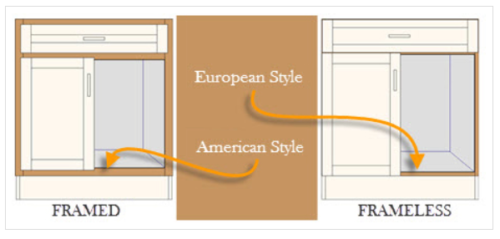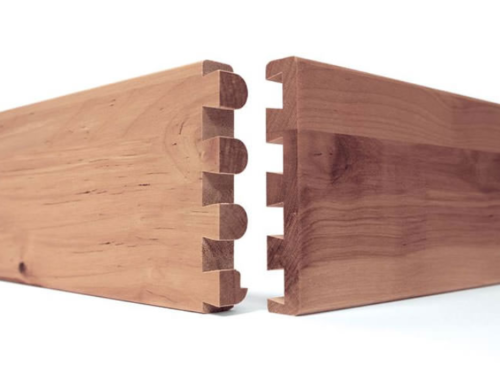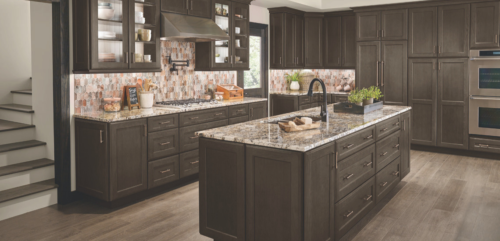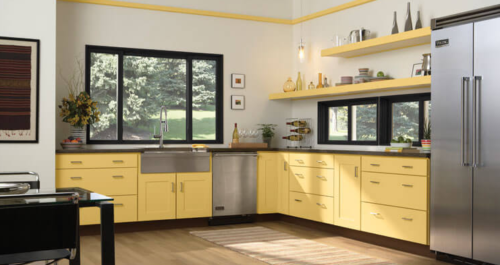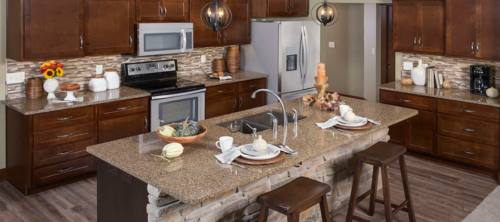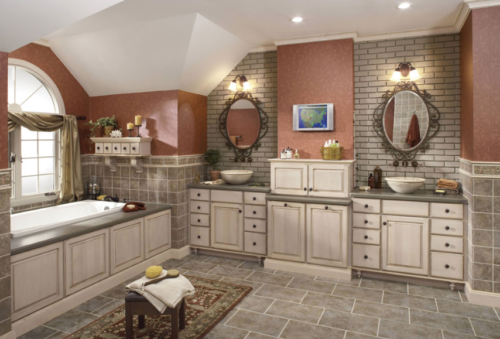High quality cabinets should look gorgeous, be functional, and built with top strength and durability. Unfortunately, sometimes we see poor cabinet construction.
The good news is that this is something you can easily avoid. Today, we will highlight a basic overview of kitchen cabinet construction and explain some key terminology.
Basic Cabinet Styles
The way a cabinet is built depends on the manufacturer. However, all cabinets come in two different designs: framed or frameless. The biggest difference between the two comes down to the face frame.
Framed vs. Frameless Cabinetry
Face-framed cabinets (also known as framed cabinets) include wood pieces around the front outer edge of the cabinet, which ‘frame’ it. The design functionality behind framed cabinets helps the entire cabinet to remain square and sturdy. Framed cabinets also offer a more classic look. However, you can get some variety and uniqueness with door overlay.
The inside portion of the frame will extend past the inside edges of the box and cause some blockage with the cabinet opening.
Frameless cabinetry is also known as full access . This is because frameless cabinets offer greater accessibility by completely eliminating the face frame. This style is very popular in Europe.
In the frameless cabinet construction process, flat panels of engineered wood (usually either particle board, plywood, or medium density fiberboard) are precisely constructed using dowels and glue.
Frameless cabinetry offers these benefits over traditional framed cabinets.
- They have no center stile allowing for more room and storage.
- Frameless cabinets have a tighter fit with less gaps between doors and drawers.
- Usually the shelves are adjustable.
- They have a thicker box construction which increases the stability.
- Typically sizes include base cabinet manufacturing on 3-inch increments from 9-inches up to 48-inches.
What Cabinet Design Should You Choose?
That answer is entirely up to you and what you’re looking to do with your space. Here are some quick facts:
Frameless Cabinetry
- Sleeker look
- Contemporary/European style
- Provides full access to cabinet interior and drawers
- Requires a more skilled installation
Framed Cabinetry
- Traditional/American style
- Face frame reinforces cabinet alignment
- Easier to install
3 Common Cabinet Construction Elements & Methods
Similar to cabinet design styles, cabinet construction methods are left up to the manufacturer. In addition to knowing some key terms, it’s important to know that cabinet construction can affect the quality, durability, and longevity of cabinets.
All About Overlays
Door overlay is defined as how much a cabinet door covers or overlaps the face frame. Cabinet doors can have three different overlays:
- Full Overlay refers to the doors and drawers covering the face frame entirely. Frameless cabinets typically come in full overlay. With a lower cost, full overlay cabinet doors provide the greatest amount of storage.
- Partial Overlay (Traditional) means the cabinet doors and drawers only partially cover the frame. This is the most common and least expensive option. Typically, the overlay leaves about 1 to 1 ¼-inch between doors and drawers.
- Full Inset is when cabinet doors and drawers are designed to fit within the face frame. On occasion, frameless lines will embody the full inset. This smooth and clean look will probably increase the cost of your cabinets and can, unfortunately, leave smaller storage spaces.
Other door details can include raised panel, which is when the center panel of the door is elevated. Recessed panel which is where the center panel is set in lower than the door frame.
Our designers also see slab door styles as being very popular. A slab door style is a solid, flat front door with no panel or face frame.
Dovetail Construction
Dovetail construction (or dovetail joints) is one of the strongest ways to join two boards together. Why? In incorporating dovetail, the ends of the two boards have v-shaped cutouts that fit in and correspond to the notches on the adjoining wood panel. They are interlocked together on right angles.
Full vs. 3/4 Extension Drawers
We’ve been talking a lot about cabinets and doors, and now it’s time to give drawers some love.
It’s important to think about functionality when designing a new kitchen or remodeling an existing one. This comes down to drawer details, specifically deciding on how far you want the drawers to extend out.
You’ll be able to open drawers the full length of the slide with a full drawer extension. This allows for greater access, especially if you’re using this drawer to hold smaller items.
¾-drawer extension means the drawer slide will only come out three-quarters of the entire length, leaving part of the drawer in the cabinet. While it doesn’t provide as much access, it is a good economical option.
Cabinet Installation
Buying fully assembled cabinets that are assembled at the factory is the best way to ensure that cabinets are properly installed, durable, and will last for years. These cabinets will be built with industrial techniques that increases the strength of them. The cabinet is a full unit with doors and drawers intact when shipped from the factory, and will be ready to install as soon as it arrives.
However, there is an alternative: ready-to-assemble (RTA) cabinets.
What are Ready-to-Assemble (RTA) Cabinets?
RTA cabinets have many benefits including:
- All plywood construction
- Nice finish and polished door profiles
- Simple offering
If you do choose to go the RTA route, there are some items that you should know before ordering:
- They are imported from overseas
- Requires an average assembly time of 20 minutes per cabinet
- Replacement parts can be hard to order
- If inventory is low, your order could take months to ship
- Usually you have to pre-pay before they ship
Typical Cabinet Construction Sizes
In addition to the basic design elements of kitchen cabinet construction and installation, the other components to understand are the “building blocks”, or main components of cabinets.
Base Cabinets
These types of cabinets mount to the floor and help support the countertops. Base cabinets usually come standard with a 24-inch depth.
A great example of using base cabinets in a unique and custom way is to incorporate them into a kitchen island.
Wall Cabinets
Wall cabinets are mounted directly to the wall and have no connection to the floor. These cabinets are usually located above countertops and ovens. The standard depth of wall cabinets are typically 12-inches.
Vanity Cabinets
On a basic level, vanity (also known as tall or pantry) cabinets are tall versions of base cabinets. Vanity cabinets stand on the floor and can either be free-standing or connected to a wall or base cabinet. A typical vanity-sized cabinet either has a depth of 18-inches or 21-inches.
For all three cabinet types, the widths start at 9-inches and will max out at 60-inches. Typical cabinet sizes will vary by the cabinet manufacturer and SKU. Work with your contractor or builder to ensure that the right cabinet and size is ordered.
Making Your Cabinets Look Beautiful: The Finishing Process
The final stage in the cabinet construction process is finishing. Getting the perfect look and feel of your cabinets depends upon a few factors. They include the type of finish, wood type, and the cabinet maker’s capabilities. Fortunately, a lot of cabinet assembly plants have modern day technology which allows for a variety of finishes to be applied.
Paint
One of the biggest trends right now for both kitchen and bathroom cabinets is paint. Why? Paint allows you to have a limitless color pallet. You can also play with colors – like the beautiful yellow paint in this kitchen.
Stain
Stains are a beautiful option if you love the natural look of wood. For a wood stain, there is a a topical color treatment. While it stains the outer layer of the wood, it will also bring out the natural grain pattern.
Glaze
Contrary to stain, a glaze allows the surface detail to shine. Typically, a glaze is a pigmented coating that’s applied overtop a paint or stain. It enhances the look of cabinets. This is a more manual process than other cabinet finishing types simply because the glaze is hand wiped off.
In reality, these are just a few finish options to choose from. Work with your builder, distributor, or cabinet company directly to explore all options.
Partnering With The Best
We are proud to offer the nation’s most popular cabinet lines, which include:
Merillat: Masterpiece & Classic
Mid Continent Cabinetry
Vista Cabinetry
Fabuwood
QualityCabinets & Woodstar
Kountry Wood Products
From our semi-custom cabinetry to value series, we offer a cabinet line that will fit your needs and budget. Most of our cabinet lines offer a variety of door styles, accessories, and storage options – everything you need to create your dream space.
If you have any questions about cabinet construction or our cabinet lines, please feel free to call our team today at 800-462-6047 and we’ll be happy to answer all of your questions.

